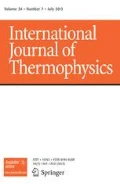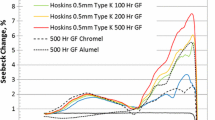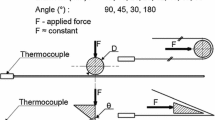Abstract
Cold-working of most thermocouples has a significant, direct impact on the Seebeck coefficient which can lead to regions of thermoelectric inhomogeneity and accelerated drift. Cold-working can occur during the wire swaging process, when winding the wire onto a bobbin, or during handling by the end user—either accidentally or deliberately. Swaging-induced cold-work in thermocouples, if uniformly applied, may result in a high level of homogeneity. However, on exposure to elevated temperatures, the subsequent recovery process from the cold-working can then result in significant drift, and this can in turn lead to erroneous temperature measurements, often in excess of the specified manufacturer tolerances. Several studies have investigated the effects of cold-work in Type K thermocouples usually by bending, or swaging. However, the amount of cold-work applied to the thermocouple is often difficult to quantify, as the mechanisms for applying the strains are typically nonlinear when applied in this fashion. A repeatable level of cold-working is applied to the different wires using a tensional loading apparatus to apply a known yield displacement to the thermoelements. The effects of thermal recovery from cold-working can then be accurately quantified as a function of temperature, using a linear gradient furnace and a high-resolution homogeneity scanner. Variation in these effects due to differing alloy compositions in Type K wire is also explored, which is obtained by sourcing wire from a selection of manufacturers. The information gathered in this way will inform users of Type K thermocouples about the potential consequences of varying levels of cold-working and its impact on the Seebeck coefficient at a range of temperatures between \(\sim 70\,^\circ \)C and \(600\,^\circ \)C. This study will also guide users on the temperatures required to rapidly alleviate the effects of cold-working using thermal annealing treatments.







Similar content being viewed by others
References
Hoskins Manufacturing Company, Hoskins Chromel-Alumel Thermocouple Alloys, Catalog M-61 (Hoskins Mfg. Co. Detroit, Mich., 1961)
N.A. Burley, R.M. Hess, C.F. Howie, J.A. Coleman, The nicrosil versus nisil thermocouple: a critical comparison with the ANSI standard letter-designated base-metal thermocouples. Temp. Meas. Control Sci. Ind. 6, 1159–1166 (1982)
E.S. Webster, Low-temperature drift in MIMS base-metal thermocouples. Int. J. Thermophys. 35, 574–595 (2014)
D.D. Pollock, D.I. Finch, The effect of cold-working upon thermoelements. Temp. Meas. Control Sci. Ind. 4, 237 (1962)
J.F. Potts Jr., D.L. McElroy, The effect of cold working, heat treatment, and oxidation on the thermal emf of nickel-base thermoelements. Temp. Meas. Control Sci. Ind. 4, 243–264 (1962)
W.P. White, The constancy of thermoelements. Phys. Rev. (Series I) 23, 449–474 (1906)
M. Campari, S. Garribba, The behavior of Type K thermocouples in temperature measurement: the chromel P-alumel thermocouples. Rev. Sci. Instrum. 42, 644–653 (1971)
R.W. McCulloch, J.H. Clift, Lifetime improvement of sheathed thermocouples for use in high-temperature and thermal transient operations. Temp. Meas. Control Sci. Ind. 6, 34 (1982)
A.W. Fenton, The travelling gradient approach to thermocouple research. Temp. Meas. Control Sci. Ind. 5, 1973–1990 (1972)
E.S. Webster, D.R. White, H. Edgar, Measurement of inhomogeneities in MIMS thermocouples using a linear-gradient furnace and dual heat-pipe scanner. Int. J. Thermophys. 36, 444–466 (2015)
D.R. White, R.S. Mason, A thermocouple homogeneity scanner based on an open pressure-controlled water heatpipe. Int. J. Thermophys. 31, 1654–1662 (2010)
P. Pavlasek, C.J. Elliott, J.V. Pearce, S. Duris, R. Palencar, M. Koval, G. Machin, Hysteresis effects and strain-induced homogeneity effects in base metal thermocouples. Int. J. Thermophys. 36, 467–481 (2015)
ASTM, Standard Specification and Temperature-Electromotive Force (emf) Tables for Standardized Thermocouples, (ASTM International, 2012)
E. Webster, D.R. White, Thermocouple homogeneity scanning. Metrologia 52, 130 (2015)
T.G. Kollie, J.L. Horton, K.R. Carr, M.B. Herskovitz, C.A. Mossman, Temperature measurement errors with Type K (Chromel vs. Alumel) thermocouples due to short-ranged ordering in Chromel. Rev. Sci. Instrum. 46, 1447–1461 (1975)
R.E. Bentley, The Handbook of Temperature Measurement Vol. 3: Theory and Practice of Thermoelectric Thermometry (Springer, Singapore, 1998)
E.S. Webster, Thermal preconditioning of MIMS Type K thermocouples to reduce drift. Int. J. Thermophys. 38, 5 (2016)
Acknowledgements
This work was carried out during a 2 month secondment by Adam Greeenen to the Measurement Standards Laboratory of New Zealand (MSL). Adam acknowledges funding from the UK National Measurement System, the NPL International Secondments Scheme and MSL in order to make this secondment possible. The authors would also like to acknowledge the efforts of Jonathan Pearce in regard to facilitation the secondment, and to MSL for being excellent hosts during Adam’s secondment.
Author information
Authors and Affiliations
Corresponding author
Additional information
Selected Papers of the 13th International Symposium on Temperature, Humidity, Moisture and Thermal Measurements in Industry and Science.
Rights and permissions
About this article
Cite this article
Greenen, A.D., Webster, E.S. Thermal Recovery from Cold-Working in Type K Bare-Wire Thermocouples. Int J Thermophys 38, 179 (2017). https://doi.org/10.1007/s10765-017-2316-5
Received:
Accepted:
Published:
DOI: https://doi.org/10.1007/s10765-017-2316-5




